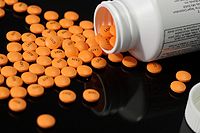
Photo from wikipedia
Patients suffering from bronchial asthma display a number of symptoms including productive coughing, wheezing, chest tightness, and shortness of breath due to increased mucus production, airway hyperresponsiveness (AHR) and episodes… Click to show full abstract
Patients suffering from bronchial asthma display a number of symptoms including productive coughing, wheezing, chest tightness, and shortness of breath due to increased mucus production, airway hyperresponsiveness (AHR) and episodes of broncho-obstruction. Depending on the severity of the disease, most symptoms appear recurrently but with a considerable variation of intensity and frequency leading the recognition of asthma as a complex and heterogeneous disease syndrome and to the formulation of different asthma phenotypes/endotypes [1]. However, since in most cases this complex disease syndrome arises on the basis of a chronic inflammatory response in the airways, the key strategy of asthma therapy is to reduce airway inflammation [2]. Consequently, oral and/or inhalative corticosteroids (CS) represent the standard treatment option for asthma patients since the 1960s [3]. Unfortunately, CS produce considerable side effects with increasing doses and especially when delivered systemically, and patients with low eosinophil counts are less responsive to CS treatment [4]. Thus, over the last two decades, asthma research concentrated on elucidating the mechanisms underlying the initiation, progression, and chronification of airway inflammation in order to unravel novel targets for therapeutic intervention. Beginning in the 1990s, the use of appropriate mouse models of experimental asthma helped to characterize T helper 2 (TH2) cells as key players in the pathogenesis of allergic asthma. By releasing a typical array of cytokines and growth factors like interleukin-4 (IL-4), IL-5, IL-9, IL-13, and granulocyte-macrophage colony stimulating factor (GM-CSF), these TH2 cells orchestrate the allergic immune response in the airways that underlies the formation of the disease. Neutralization of each of these cytokines markedly improved disease symptoms in mouse models of experimental allergic asthma [5]. Consequently, the development of monoclonal antibodies and other biologicals targeting their human equivalents lead to the identification of several promising candidates for novel asthma treatment options. Although showing promising preclinical results, targeting IL-4 (pascolizumab [6], pitrakinra [7], AMG-317 [8]) failed to improve asthma symptoms in clinical trials and appears to be ineffective in established disease. Also antibodies neutralizing IL-9 (MEDI-528 [9]) or IL-13 (lebrikizumab [10], GSK679586 [11], IMA-026 [12]) were discontinued due to lack of efficacy in clinical asthma trials. While another IL-13 neutralizing antibody (tralokinumab [13]) is now tested phase III clinical trial, to date only anti-IL-5 antibodies (benralizumab [14], mepolizumab [15], reslizumab [16]) have been approved for treatment of severe persistent, allergic asthma with high eosinophil counts. The relatively modest effects of these candidates for asthma therapy emphasized that asthma is a complex disease syndrome with many phenotypes/endotypes, which require tailored therapy, and that targeting TH2-cytokines could be a treatment option in a special population of asthma patients displaying hypereosinophilia. Consequently, proinflammatory cytokines that are not specifically involved in allergic immune responses but rather generally contribute to initiation and continuation of inflammatory reactions such as IL-1β, IL-17, and tumor necrosis factor (TNF) α moved into focus. Surprisingly, a number of attempts to neutralize the activity of these factors with antibodies like canakinumab, brodalumab [17], adalimumab, golimumab [18], and infliximab did not produce convincing results in clinical trials [19]. None of these agents reduced inflammatory cell counts or produced significant improvements of the clinical outcomes, but raised serious concerns over the safety of TNF-α-blockade and an increased susceptibility to respiratory infections. Although further antibodies (e.g. ixekizumab, secukinumab, tezepelumab) neutralizing the proinflammatory activity of cytokines like IL-17, IL-33, and thymic-stromal lymphopoietin (TSLP) [20–22] are currently under investigation and produced promising results in animal disease models, one could assume that just inhibiting the proinflammatory factors may not the ideal solution for asthma therapy. Indeed, it could also be an option to support the anti-inflammatory response in order to counterbalance airway inflammation. Unfortunately, in contrast to the plethora of cytokines that has been discovered over the last years to conduct allergic inflammatory processes, the number of regulatory cytokines is surprisingly small. Among those factors are rather specific molecules like the soluble TNF-α receptors (sTNF-αR) or IL-1RA that neutralize the functions of their respective cytokines or generally antiinflammatory cytokines such as TGF-β and IL-10 that inhibit the proinflammatory activities of IL-1β, IL-6, TNF-α, GM-CSF,
Journal Title: Expert Review of Respiratory Medicine
Year Published: 2017
Link to full text (if available)
Share on Social Media: Sign Up to like & get
recommendations!